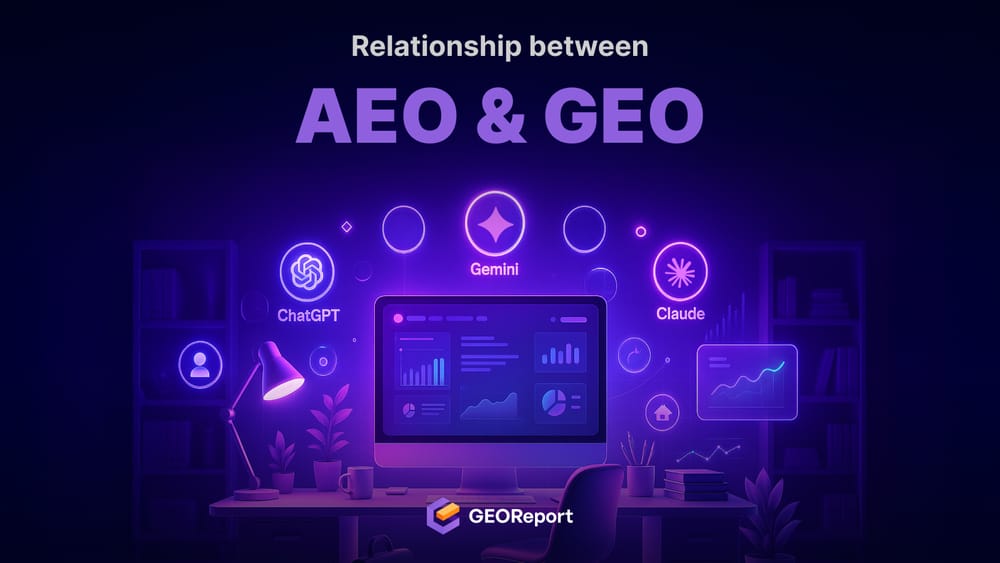Answer Engine Optimization (AEO) makes your content understandable and extractable by AI systems, while Generative Engine Optimization (GEO) makes it trusted and reusable across reasoning engines.
Together, they transform SEO AI into a system of visibility and credibility, helping your brand move from being mentioned to being remembered. The future of AI and SEO isn’t about keywords anymore, it’s about clarity, consistency, and reasoning depth.
How the Web Evolved Beyond Traditional SEO
For two decades, SEO built the foundation of digital visibility. Brands competed for ranking positions, backlinks, and organic clicks. But in 2025, the paradigm shifted. Search engines have become answer engines, and users now read AI summaries more often than they visit sites.
According to Similarweb, over 58% of global searches are zero-click, meaning users never leave the AI-generated interface. This change has redefined what it means to “show up” online.
In this new environment, AEO bridges the gap between traditional SEO and AI reasoning. It ensures your content is structured, factual, and short enough to be extracted by models like ChatGPT or Gemini. But visibility alone isn’t sustainable.
To maintain AI Visibility, your content must not only appear but also inform the model’s logic. That’s where Generative Engine Optimization (GEO) enters because it helps AI use your content as part of its reasoning chain.
When marketers understand this shift, they stop optimizing only for clicks and start optimizing for citations, context, and coherence. That’s the core of modern SEO AI strategy: structure what AI can quote, and reason what AI can trust.
The Three Layers of AI Visibility
The modern visibility stack has three tiers. Each tier supports the next, forming a continuous pipeline of discovery, interpretation, and reasoning.

| Layer | Core Focus | AI Behavior | Brand Outcome |
|---|---|---|---|
| SEO | Discoverability | Finds indexed content | Users see your link |
| AEO | Answerability | Extracts short factual statements | AI quotes your definition |
| GEO | Reasoning | Uses verified logic in multi-step explanations | AI trusts your insight |
- Traditional SEO focuses on finding.
- AEO focuses on explaining.
- Generative Engine Optimization (GEO) focuses on understanding.
This is the difference between visibility and credibility, both essential to sustain long-term AI and SEO performance.
How AEO Feeds GEO: The Reasoning Pipeline
AEO and GEO are not competing models; they are sequential layers of AI interpretability. AEO provides the structured answers; GEO builds the semantic reasoning on top of them. Together, they form the data-to-trust pipeline that fuels AI-generated results.
Step 1. AEO: Structuring Information for Extraction
AEO makes your content digestible for AI. It converts long paragraphs into short, factual blocks that can be directly quoted. This involves writing concise definitions, using consistent schemas (FAQ, HowTo), and embedding contextual evidence. The goal is to make every paragraph answer-ready.
Example: “According to GEOReport.ai, AEO structures web content so AI engines can accurately extract and cite it inside their generated responses.”
Such clarity tells AI exactly what statement to use and where to attribute it.
Step 2. GEO: Turning Facts into Reasoning
Once AEO provides accurate, clean information, Generative Engine Optimization (GEO) takes over. GEO helps AI not just quote your content, but reuse your reasoning when forming more complex answers. It ensures that across multiple questions, your brand’s logic, tone, and trust signals remain consistent, creating a form of “semantic recall.”
For example, AI may first quote your AEO-defined fact: “AEO is a process of formatting content for AI answers.” Then, in another query, it builds on that by saying: “Generative Engine Optimization expands on AEO by helping AI understand and reason through brand logic.”
That is the leap from being found to being trusted.
Step 3. Continuous Feedback Between AEO and GEO
AEO feeds GEO the raw material; GEO amplifies AEO’s impact by building context around it. This feedback loop is what creates true AI Visibility where your brand’s reasoning becomes part of AI’s own model of understanding.
What Is The Difference Between AEO and GEO?
While both systems share a foundation in clarity and evidence, their objectives differ. The table below highlights their complementary strengths.
| Dimension | AEO | GEO |
|---|---|---|
| Primary Goal | Be answerable | Be reasoned with |
| Optimization Focus | Clarity and structure | Consistency and logic |
| Preferred Content Type | Short factual blocks | Multi-layer explanations |
| Validation Criteria | Schema, citations, factual correctness | Entity consistency, reasoning depth |
| Success Metric | AI citation frequency | Reasoning reuse and trust weight |
In practice, AEO is tactical; GEO is strategic. AEO earns you mention-level visibility; GEO earns you reasoning-level authority. Combined, they unlock a compounding advantage in SEO AI performance, content that not only shows up but stays relevant across prompts, contexts, and updates.
Building the Bridge: AEO-to-GEO Transition Framework
The transition from AEO to GEO happens in four deliberate steps. This framework turns visibility into reasoning influence.

1. Audit for Answer Readiness
Start by identifying which content pieces are already being cited by AI systems or shown in AI Overviews. Audit your FAQ sections, definitions, and schema accuracy. Look for answers that are clear, self-contained, and under 70 words. These are your “answer blocks.”
2. Expand Factual Answers into Contextual Explanations
Every strong AEO section should grow into a GEO-ready reasoning block. That means pairing what with why. For example, if your AEO snippet defines “AI Visibility,” the GEO version should explain how consistent brand signals strengthen that visibility across reasoning engines. Include supporting data or a small case example to anchor the reasoning.
3. Interlink Logic Across Pages
GEO thrives on semantic coherence. Align terminology, tone, and data points across your site. Instead of linking pages by anchor text alone, connect them through cause-effect narratives. Use consistent entity markup (sameAs, about) to help AI see your brand as a coherent reasoning source.
4. Track Multi-Layer Performance
Use metrics beyond traffic to measure GEO progress. GEOReport.ai identifies three core indicators:
- Visibility Depth Index (VDI): Measures surface vs reasoning inclusion ratio.
- Reasoning Depth Ratio (RDR): Tracks how often your content appears in multi-step reasoning.
- Entity Confidence Stability (ECS): Monitors how consistently AI models interpret your brand identity.
When your RDR and ECS rise together, it means your brand has moved beyond being an answer, it has become a reasoning source.
Case Study: How GEOReport.ai Demonstrates the AEO–GEO Connection
In 2025, GEOReport.ai analyzed 500 brand domains across industries to measure how AEO structure impacts GEO authority. The study revealed that strong AEO foundations significantly improve GEO reuse rates.
- 60% of brands with robust schema and concise answer blocks appeared in AI Overviews.
- Only 20% of those were used in reasoning chains.
- After integrating GEO-focused logic and entity mapping, inclusion in reasoning layers tripled within two months.
This demonstrates how visibility alone isn’t enough. To shape perception in the age of generative systems, your content must be reason-aware.
Why the AEO–GEO Relationship Defines the Future of SEO AI
AEO and Generative Engine Optimization (GEO) together form the foundation of AI and SEO convergence where human readability meets machine reasoning. Marketers who adapt early will shape not only what AI shows but how AI thinks about their brands.
AEO establishes credibility through clarity and factual alignment. GEO extends it by connecting those facts into consistent, reasoned arguments. In a generative search ecosystem, this combination ensures your brand maintains high AI Visibility even when no one clicks.
Marketers still optimizing for links and impressions will find diminishing returns. Those optimizing for inclusion and reasoning will own the next phase of digital trust.
How to Integrate AEO and GEO into Your AI Visibility Strategy
To align both systems effectively, approach AEO and GEO as a single continuum — not separate departments.
- SEO AI Foundation: Maintain traditional SEO health including crawlability, indexability, and metadata accuracy.
- AEO Layer: Implement schema, write answer blocks, validate citations, and monitor AI inclusion.
- GEO Layer: Expand logic flow, interlink reasoning clusters, and test consistency across models.
- Measurement: Track VDI, RDR, and ECS quarterly.
- Iteration: Refine sections that appear in AI answers but not in reasoning, those are missed opportunities.
This process shifts your marketing from chasing rankings to building reasoning ecosystems that continuously reinforce your authority in AI-driven search.
Editor’s Note
Generative Engine Optimization (GEO) isn’t the death of SEO because it’s its evolution. Answer Engine Optimization ensures you appear. GEO ensures you endure. Together, they redefine the metrics of modern visibility: not just who gets seen, but who gets trusted.
In 2025, every brand competes inside AI-generated explanations. To stay relevant, your words must do more than rank, they must reason. AEO teaches AI what you say. GEO teaches it why you’re right.

